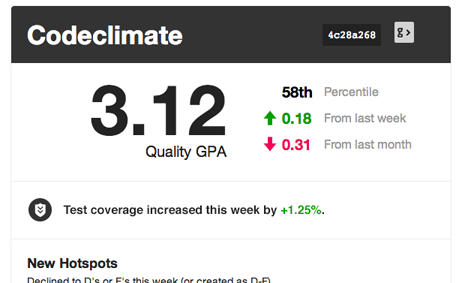Code quality and test coverage information often live in separate silos. Code Climate has always been able to help you understand the complexity of your code, but to look at your test coverage required a different set of tools (like SimpleCov). This made it harder than necessary to answer key questions like:
- “Which areas of my app are both low quality and untested?”
- “How well covered is this method I’m about to refactor?”
- “Should I beef up integration testing coverage before this large-scale change?”
Today, we’re proud to announce the full integration of test coverage metrics into Code Climate. To make it dead simple to get started, we’re also partnering with three awesome companies that are experts at running your tests – Semaphore, Solano Labs, and Travis CI. (More on this below.)
Having test coverage side-by-side with code quality enables your team to make better decisions earlier in your development process, leading to more maintainable code that is easier to work in. Here’s a quick look:

Just like with code quality, we surface test coverage information at the repository, class, and source listing level (down to an individual line of code) and provide feedback as metrics change over time in the form of email alerts, activity feeds, chat notifications and RSS.
With just a few minutes of setup you can:
- View test coverage reports for each class alongside other metrics like complexity, duplication, and churn.
- Toggle between viewing code smells and test coverage line-by-line on the same source listings (see above).
- Track your team’s test coverage in your weekly summary emails and Code Climate feed.
Here’s a couple examples of Code Climate’s test coverage integration …
… in your chatroom:

… and in your weekly summary email:

We think the addition of test coverage to our code quality offering is a powerful upgrade in our mission of helping free teams from the burden of technical debt and unmaintainable code. Give it a try today, and let us know what you think.
How does test coverage work?
Code Climate does not run your code, and that’s not changing. Instead, our new test coverage feature works by accepting coverage data sent from wherever you are already running your tests. This means you can use Code Climate’s new test coverage feature with your existing continuous integration (CI) server. (In a pinch, you could even send up test coverage data from your laptop, or anywhere else.)
We’ve released the codeclimate-test-reporter RubyGem that you install into your Gemfile. When your tests finish, it sends an HTTPS post to us with a report on which lines of code were executed (and how many times).
Test Coverage is included in all our currently offered plans. To turn it on for a specific repo, just go to your repository’s feed page, click “Set up Test Coverage” and follow the instructions.
Our Partners
Some of you might not have a CI server in place for your project, or perhaps you’ve been frustrated maintaining your own CI server and are looking for something better. We believe cloud-based CI is the future and are excited to partner with three fantastic CI providers – Semaphore, Solano Labs, and Travis CI – to ensure you can integrate their services with just a few clicks.

All three of our partners save you from the headaches of administering a CI server (like Jenkins) on your own – time and money that adds up quickly. If you’re looking to make a move to a cloud CI vendor, now is a great time.
Joining forces with three companies that are experts at running your tests – safely, quickly and with little effort – means we can stay focused on what we do best. To get started with one of these great partner offers, login to your Code Climate account and head to the Test Coverage setup tab for one of your repos.
Get articles like this in your inbox.
Trending from Code Climate
1.
Engineering Leaders Share Thoughts on Leadership in Disrupted Times in a New Survey
For engineering teams, disruption to the business can have a significant impact on the ability to deliver and meet goals. These disruptions are often a result of reprioritization and budget changes on an organizational level, and are amplified during times of transition or economic instability.

2.
Built In’s 2023 Best Places to Work — Why Code Climate Made the List
At Code Climate, we value collaboration and growth, and strive for greatness within our product and workplace. For us, this means fostering a supportive, challenging, people-first culture. Thanks to an emphasis on these values, we’ve earned spots on three of Built In’s 2023 Best Places to Work awards lists, including New York City Best Startups to Work For, New York City Best Places to Work, and U.S. Best Startups to Work For.

3.
Turnkey Deployment Delivers Day-One Value for Yottaa
Learn how Yottaa gained immediate value from Code Climate Velocity right out of the box.

Get articles like this in your inbox.
Get more articles just like these delivered straight to your inbox
Stay up to date on the latest insights for data-driven engineering leaders.

